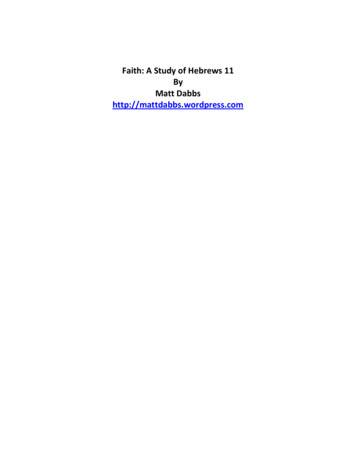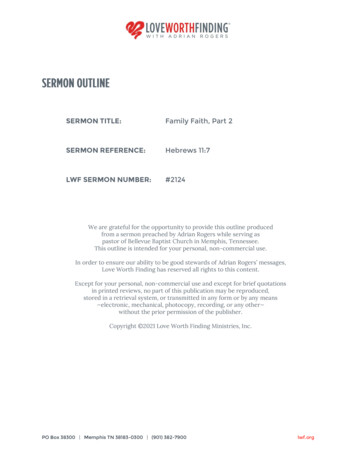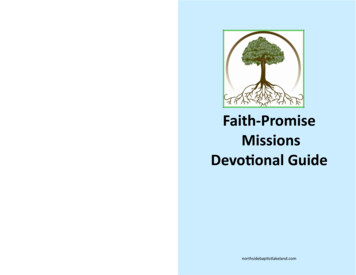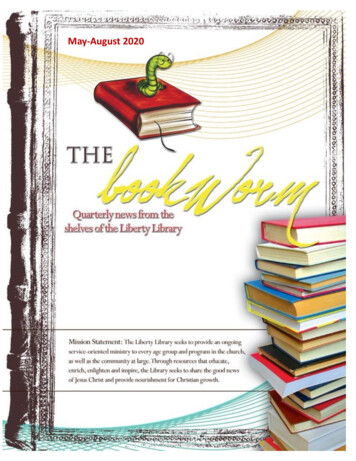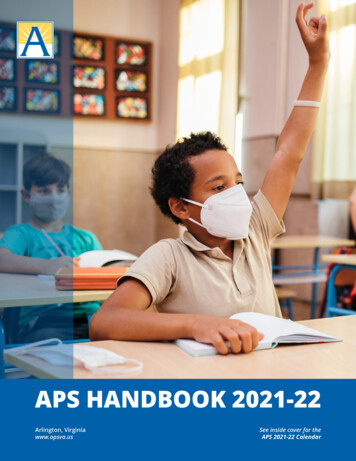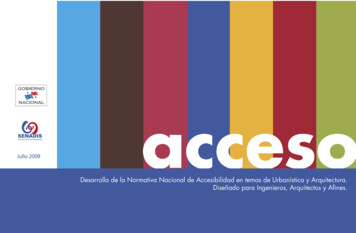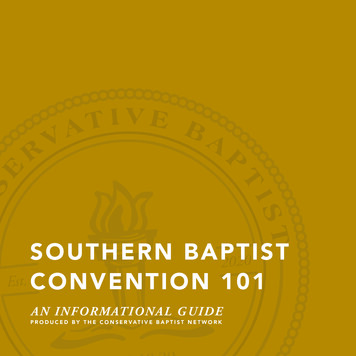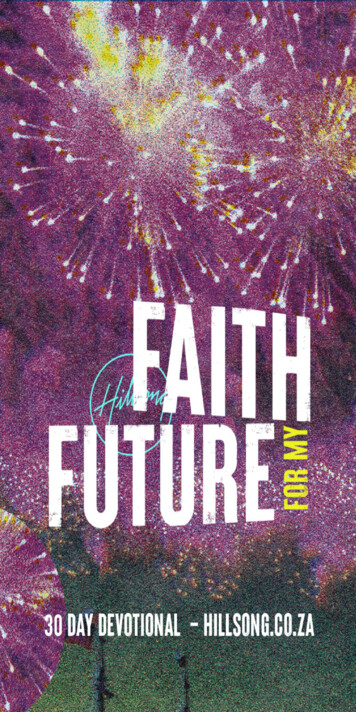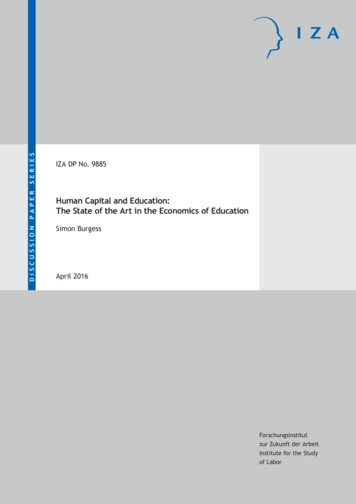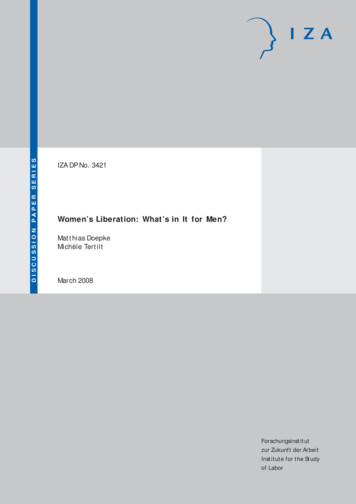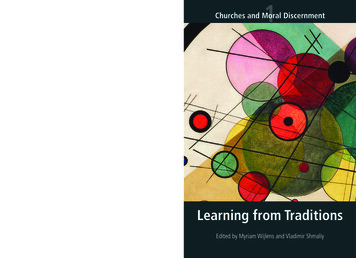
Transcription
1Churches and Moral DiscernmentLearning from traditions—In our times moral issues seem to be a challenge to preserving unity within different churches as well as a frequent obstacle to restoring visible unity betweenthe churches. In response, this is the first of three volumes resulting from thework of a Faith and Order study group on moral discernment in the churches.Myriam Wijlens, a Dutch Roman Catholic theologian and canon lawyer, teaches at the University of Erfurt (Germany). Her research focuses on necessary reforms of canonical structures inlight of ecumenically relevant ecclesiological developments. Among her publications is Sharingthe Eucharist.CHURCHES AND MORAL DISCERNMENT 1The volume features 14 self-descriptions of different traditions regarding moraldiscernment: their sources, the interplay of sources, and the processes of ecclesial deliberation. The different self-descriptions are presented to enable reflectionon and provide awareness of how processes of moral discernment are envisionedby the respective traditions. They invite the reader, as well as churches, to studythem, reflect on the moral discernment of their own tradition, and learn howothers engage in moral discernment.Wijlens / Shmaliy“The focus is on hearing from fellow-Christians – those of earlier generations, as well as contemporaries from different traditions – about how theyrespond in practice to the call of Christ; how they interpret their situations,how they engage in processes of moral discernment, and how they reach andimplement decisions.”—from the IntroductionVladimir Shmaliy is an associate professor of theology and vice-rector for academic affairs atthe Moscow Theological Academy. An archpriest of the Russian Orthodox Church, he has servedhis church in many ecumenical dialogues and as a theological consultant to the Department ofExternal Church Relations of the Moscow Patriarchate. His research has ranged widely, including intheological anthropology and religion and science.FAITH AND ORDER PAPER 228ECUMENISM / ETHICSLearning from TraditionsEdited by Myriam Wijlens and Vladimir Shmaliy
Churches and Moral Discernment
ChurchesandMoral DiscernmentVolume 1Learning from TraditionsEdited by Myriam Wijlens and Vladimir ShmaliyFaith and Order Paper No. 228
CHURCHES AND MORAL DISCERNMENTVolume 1: Learning from TraditionsCopyright 2021 WCC Publications. All rights reserved. Except for brief quotations in noticesor reviews, no part of this book may be reproduced in any manner without prior written permission from the publisher. Write: publications@wcc-coe.org.WCC Publications is the book publishing programme of the World Council of Churches. Founded in1948, the WCC promotes Christian unity in faith, witness and service for a just and peaceful world.A global fellowship, the WCC brings together more than 350 Protestant, Orthodox, Anglican andother churches representing more than 560 million Christians in 110 countries and works cooperatively with the Roman Catholic Church.Opinions expressed in WCC Publications are those of the authors.Scripture quotations are from the New Revised Standard Version Bible, copyright 1989 bythe Division of Christian Education of the National Council of the Churches of Christ in theUSA. Used by permission.Cover design, book design and typesetting: Michelle Cook / 4 Seasons Book DesignCover image: Vassily Kandinsky, Circles in a Circle (detail), 1923.ISBN: 978-2-8254-1735-5World Council of Churches150 route de Ferney, P.O. Box 21001211 Geneva 2, Switzerlandhttps://www.oikoumene.org
ContentsContributorsPreface Myriam Wijlens and Vladimir ShmaliyIntroduction Rachel Muers and Kristina Mantasasviliviiixxv1. Eastern OrthodoxApproaching Moral Questions from the Conscience of the ChurchMetropolitan Vasilios and Kristina Mantasasvili12. Syrian OrthodoxInspired by Ephrem the Syrian: Moral Discernmentwith a Therapeutic ApproachMor Polycarpus A. Aydin93. Coptic Orthodox Moral Discernment through the Praxical Pursuit of GodStephen M. Meawad214. Armenian Orthodox Sources for Moral Discernment: Armenian Apostolic TraditionShahe Ananyan295. Roman Catholic Catholic Ethical Teaching: Between Infallibility and the Sense of the FaithfulJosef Römelt376. Old Catholic Conscience Formed within the Community: Moral Discernmentin the Old Catholic ChurchTheresa Hüther497. Lutheran Respecting the World, Engaging in the World: Basic Principlesof Lutheran EthicsBernd Oberdorfer578. Reformed Sharing Power to Discern the Will of God in Every Time and PlaceRebecca Todd Peters71
viContents9. Anglican Anglican Moral Discernment: Sources, Structures, and Dynamicsof AuthorityJeremy Worthen8110. Historic Peace Churches Peace at the Heart of Ecclesial Moral DiscernmentRachel Muers9111. Baptist Baptist Moral Discernment: Congregational Hearing and WeighingSteven R. Harmon9912. Methodist The Role of Authority in Moral DiscernmentMorag Logan11513. Disciples of Christ Disciples of Christ: Renewal, Unity, and Social WitnessKristine A. Culp12714. Pentecostal Word, Spirit, and DiscernmentCecil M. Robeck, Jr.137Appendices:1. Moral Discernment in the Churches: A Study Document (2013)2. Faith and Order Study Group on Moral Discernment: Members146191
ContributorsRev. Dr Shahe Ananyan, Ecumenical Officer, Armenian Apostolic Church,Mother See of Holy Etchmiadzin (Armenia)Dr Kristine A. Culp, Dean of the Disciples Divinity House and Associate Professor of Theology at the Divinity School, University of Chicago (USA)Dr Steven R. Harmon, Professor of Historical Theology, Gardner-Webb University School of Divinity, Boiling Springs, North Carolina (USA)Ms Theresa Hüther M.A., Research Assistant at the Old Catholic Seminary at theUniversity of Bonn (Germany)Rev. Dr Morag Logan, Uniting Church of Australia, University Chaplain, Carlton (Australia)Ms Kristina Mantasasvili, Ecumenical Patriarchate, Department of EuropeanEducational Programmes, Aristotle University of Thessaloniki (Greece)Dr Stephen M. Meawad, Adjunct Professor of Catholic Studies at Sacred HeartUniversity (Connecticut, USA); Adjunct Professor of Religious Studies andTheology at the University of St. Joseph (Connecticut, USA)Dr Rachel Muers, Society of Friends (Quakers), Professor of Theology, University of Leeds (UK)Dr Bernd Oberdorfer, Professor of Systematic Theology, University of Augsburg(Germany)Rev. Dr Rebecca Todd Peters, Professor of Religious Studies and Director of Poverty and Social Justice at Elon University (North Carolina, USA); OrdainedMinister of Word and Sacrament in the Presbyterian Church (USA)H.E. Dr Polycarpus A. Aydin, Metropolitan for the Archdiocese of the Netherlands of the Syriac Orthodox Church (Netherlands)Dr Cecil M. Robeck, Jr., Ordained Minister of the Assemblies of God, SeniorProfessor of Church History and Ecumenics; and Special Assistant to the President for Ecumenical Relations at Fuller Theological Seminary, in Pasadena,California (USA)vii
Rev. Dr Joseph Römelt, CSsR, Professor of Moral Theology and Ethics, CatholicFaculty of Theology, University of Erfurt (Germany)Rev. Dr Vladimir Shmaliy is Associate Professor of Theology and Vice-Rector ofthe Moscow Theological Academy.H.E. Metropolitan Dr Vasilios of Constantia – Ammochostos, Church of Cyprus(Cyprus)Dr Myriam Wijlens, Professor of Canon Law, Catholic Faculty of Theology,University of Erfurt (Germany)Rev. Dr Jeremy Worthen, Secretary for Ecumenical Relations and Theology at theCouncil for Christian Unity of the Church of England (UK)
PrefaceMyriam Wijlens and Vladimir ShmaliyThis is the first of three volumes resulting from the work of the Faith and OrderStudy Group 3 on moral discernment in the churches. From the 1980s onward,the topic of ethics has been on the agenda of the Faith and Order Commission. Indeed, in our times moral issues seem to be a challenge to preservingunity within different churches as well as a frequent obstacle to restoring visibleunity between the churches. The topic of moral issues has been on Faith andOrder’s agenda with the aim “to clarify the theological inter-relation betweentwo fundamental ecumenical concerns: the quest for visible unity of Christ’sChurch and the implementation of the Christian calling to a common witnessand service in today’s world.”1 Over the years, the Faith and Order Commissionhas published various studies, alone or in cooperation with other ecumenicalinstitutions: for example, the 1990 document Church and World;2 the 1997published documents “Costly Unity,” “Costly Commitment,” and “CostlyObedience”;3 and the 2005-issued document Christian Perspectives on Theological Anthropology: A Faith and Order Study Document.4The First Phase: Moral Discernment in the Churches–A Study Document (2006–2013)Following from its previous studies, the Standing Commission on Faith andOrder in its 2006 meeting decided to “conduct a study of the ways in whichthe churches formulate and offer teaching and guidance with respect to moraland ethical issues – especially those that are or may become church-dividing,1. Commission on Faith and Order, Minutes of the Meeting of the Standing Commission 1986Potsdam, GDR, Faith and Order Paper No. 134 (Geneva: WCC Publications, 1986), 28.2, Church and World: The Unity of the Church and the Renewal of Human Community: A Faithand Order Study Document. Faith and Order Paper No. 151 (Geneva: WCC Publications,1990).3. In Thomas F. Best and Martin Robra, eds, Ecclesiology and Ethics: Ecumenical EthicalEngagement, Moral Formation and the Nature of the Church (Geneva: WCC Publications,1997).4. Christian Perspectives on Theological Anthropology, Faith and Order Paper No. 199 (Geneva:WCC Publications, 2005).ix
xPrefacee.g. human sexuality.”5 It undertook this study in 2007, with the working title“Moral Discernment in the Churches.” Over the course of this work, the commission clarified that its purpose was “to gain a deeper understanding of thenature of theological difference and disagreement in order to develop studymaterial and resources that facilitate difficult conversations and theological discussions about moral issues.”6 The commission finalized its text, MoralDiscernment in the Churches: A Study Document (hereafter MDC) in 2012 andpublished it in 2013.7MDC is indeed a study document. It focuses not on moral questions per se,but rather on the discernment process that occurs as churches search for answersto moral questions. The purpose of the document is not to solve any moralissue, evaluate which moral decision is right, or impose any method of moraldiscernment. Rather, its purpose is to help churches understand why differentconclusions on moral issues occur within and between churches.Although the Faith and Order Commission decided to move beyond acomparative method, it has turned out to be a major challenge to find an appropriate approach for the task assigned. Indeed, discussions on moral issues areaffected by factors that complicate the task of ecumenical dialogue, as stated inthe “Introduction” of MDC:1. Moral questions reflect deeply-held theological beliefs about sin andhuman nature.2. Moral questions are often encountered within the context of personalexperience and are therefore deeply emotionally charged.3. Certainty about the rightness or wrongness of one’s own or another’sposition on a moral issue – whether based on the authority of churchteachings, spiritual guidance, or individual discernment – can makedialogue across lines of difference extremely difficult.4. Churches engage in the process of moral discernment in culturally andecclesiologically distinct ways that are often not known or understoodby one another.5. Minutes of the Standing Commission on Faith and Order, Faverges, Haute-Savoie, France2006, Faith and Order Paper No. 202 (Geneva: WCC Publications, 2006), 107.6. Minutes of the Standing Commission on Faith and Order meeting in Cairo, Arab Republic ofEgypt 2008, Faith and Order Paper No. 208 (Geneva: WCC Publications, 2009), 54.7. World Council of Churches, Moral Discernment in the Churches: A Study Document, Faithand Order Paper No. 215 (Geneva: WCC Publications, 2013). Published as Appendix 1 ofthis book. Also accessible at https://archive.org/details/wccfops2.222.
PrefacexiThese difficulties arise at all levels in churches and communities: betweenindividuals, within churches, and between churches. Although all churcheshave basically the same sources, how they engage these sources and the authority they give them differs greatly. But people are not always aware of this (seeMDC, Introduction).For this reason, MDC presents a descriptive account of possible factorsbehind the similarities and differences in the moral discernment process. Thedocument describes sources churches use when engaging in moral discernmentand presents possible causative factors for when they arrive at conclusions thatdiffer – not only from other churches but also from their own previous moraldecisions. MDC is intended as a tool to help churches become aware of (1) howthey engage in moral discernment, (2) what sources and factors influence thatprocess, and (3) how different sources and factors operate in discernment processes of other people and churches. A deeper knowledge of one’s own traditionor others is a necessary prerequisite for dialogue on moral topics.The publication of MDC was not easy. Orthodox members of the Faithand Order commission wished to add an addendum that stated that the document “could be used in Orthodox theological schools and academic circles”but expressed some “concerns regarding the whole study process. The Orthodox read the text in ways that do not reflect their tradition” (MDC, “OrthodoxAddendum”). The addendum mentions, in particular, the methodology usedand the way the sources are presented in relation to each other. The addendumexplicitly recommends that MDC be presented to the 2013 WCC assembly asa preliminary work in a more extensive study and that moral discernment beplaced on the agenda of Faith and Order in the future. The Roman CatholicChurch added a footnote to this addendum expressing that Catholics wouldshare similar concerns, but would endorse it be presented to the WCC 2013 asa preliminary stage of a study that Faith and Order might continue in the future.The Second Phase: Churches Engagingin Moral Discernment (2015–2021)In light of the difficult birth of the 2013 MDC, as well as considering that thetopic evokes very strong emotions, the Faith and Order Commission approvedthe proposal presented by its newly composed 2015 Study Group on moraldiscernment to undertake two projects. Both projects would allow for a faithfuldescription of what occurs in a certain tradition and would also provide for acertain emotional distance from the project, allowing for a fruitful conversation. Two large projects were initiated.
xiiPrefaceThe first project was entitled Church Traditions. The aim was to presentself-descriptions of traditions as they engage in a moral discernment process.With the help of MDC, scholars reflected on and presented how their owntradition engages in a moral discernment process. These scholars were eithermembers of the Faith and Order Commission or persons selected after consultation with members of their tradition who are on the commission. The scholarsshared reflections about their own tradition, but these reflections neverthelesspresented the personal views of the authors. The study group received 14 studies and is pleased to present them in this volume. They are from the followingtraditions: Eastern Orthodox, Syriac Orthodox, Coptic Orthodox, ArmenianOrthodox, Roman Catholic, Old Catholic, Lutheran, Reformed, Anglican,Historic Peace Churches, Baptist, Methodist, Disciples of Christ, and Pentecostal. The study group received the studies by (1) listening to them attentively, (2)asking questions to understand the discernment process as described, and (3)engaging in dialogue to grasp where the similarities and differences between thedifferent traditions lie. The method was again merely descriptive. The purposewas not at all to be normative. The study group presented its initial findings atthe Faith and Order Commission meetings in 2017 and 2019.The second project of studies undertaken, entitled Historical Examples,focused on discernment processes that took place with changing views on specific moral topics within different traditions over the course of history. Thecriteria for selecting the topics included that the change had to have occurredin the past and that that change is no longer debated. It was felt that examplesfrom history might allow for a more objective and less emotional discussion. Amajor purpose was to learn from the past for the future.Hence, the Study Group invited authors of the studies to shed light onthe process behind modification or change in a position on a moral issue. Thefollowing questions were posed to the authors: What triggered engagement ina process of reconsidering a moral position? How did that process evolve? Howwas the argument built? What elements played a role? How did it come about?Who was involved in the decision-making? What authority did these personshave? And since change does not come overnight: What helped the traditionavoid a division as the change occurred over a certain period of time? The commission suggested that the authors use MDC as a guide in responding to thesequestions. Again, the method was analytical and descriptive, not normative.The project received 19 papers from different traditions on different topics.They will be presented in volume two. The introduction to that volume willprovide more information about the topics chosen.88. Myriam Wijlens, Vladimir Shmaliy, Simone Sinn, eds., Churches and Moral Discernment,volume 2: Learning from History, Faith and Order Paper No. 229 (Geneva: WCC Publications, 2021) forthcoming.
PrefacexiiiAnd finally, the third volume of this series will consist of a concludingreport by the Faith and Order Commission about its findings from these twoprojects.9The Current VolumeThe current volume includes 14 self-descriptions of different traditions regarding moral discernment. They are preceded by an introduction that attends tothe ecclesiological aspect of the self-descriptions. The different self-descriptionsare presented for study: to reflect upon and provide awareness of how processesof moral discernment are envisioned by the respective traditions. They invitethe reader, as well as churches, to study them, reflect on the moral discernmentof their own tradition, and learn how others engage in moral discernment. Thehope is that necessary prerequisites are fulfilled, allowing for constructive conversations within traditions. This will prevent divisions over moral issues andprovide solid ground to engage in fruitful ecumenical dialogues that appreciateand attribute appropriate relevance to moral issues.The reader may already be informed that several members of the studygroup experienced a surprise in engaging in these two processes. While the selfdescriptions published in this first volume reveal differences in how traditionsengage in moral discernment, when they are considered in combination withthe examples from history we find that this does not always lead to differentoutcomes. Indeed, despite differences in process, the outcome of moral discernment – that is, the moral position itself – might be very similar if not the same.By the same token, the historical studies reveal that similarities in how churchesengage in moral discernment might not necessarily lead to the same or similaroutcomes. Hence, the studies in the two volumes make for interesting reading.As co-chairs of the study group on moral discernment in the churches since2015, we would like to express a word of gratitude in particular to the membersof the study group for their engagement and to the authors of the studies whoassisted us in these projects. A special word of thanks is to be expressed to thestaff members of the Faith and Order Commission, Rev. Dr Dagmar Heller(2015–2018) and Rev. Dr Simone Sinn (since 2018). Without their expertise, invaluable advice, and enthusiasm, the work accomplished would not havebeen possible.9. Faith and Order Commission, Churches and Moral Discernment, volume 3: FacilitatingDialogue to Build Koinonia, Faith and Order Paper No. 235 (Geneva: WCC Publications),forthcoming.
IntroductionRachel Muers and Kristina MantasasviliMoral Discernment and the Faith and Order CommissionSince at least the early 1980s, the Faith and Order Commission of the WorldCouncil of Churches (WCC) has recognized the importance of engaging withissues of moral discernment in the churches. Moral and ethical issues are oftenthe cause of disunity and division within and between the churches; moreover,processes of moral discernment affect and reflect core aspects of the life of eachchurch and of the life the churches share. The collection of papers presentedhere is offered as a new contribution toward deepening mutual understandingamong Christian communities, as they seek together in faith the unity to whichChrist calls them.In pursuance of its mandate to “serve the churches as they call one anotherto visible unity,” the Faith and Order Commission has undertaken numerousstudies related to moral discernment in the churches, most recently Moral Discernment in the Churches (2013, hereafter MDC).1 MDC was “seen as a reporton the first stage of a study process that is called to continue.” At its first meeting in Caraiman (Romania) in 2015, the current Commission on Faith andOrder appointed a study group to continue work on moral discernment processes in the churches and to identify uniting and dividing factors.2 Respondingto specific needs identified following the MDC process, the study group wasasked to pay particular attention to the role and nature of authority in moraldiscernment.The aim of the study group’s work, which is reflected in this collectionof papers, is a modest one: it is to serve the churches by enabling them to1. World Council of Churches, Moral Discernment in the Churches: A Study Document, Faithand Order Paper No. 215 (Geneva: WCC Publications, 2013). Published as Appendix 1 ofthis book. Also accessible at https://archive.org/details/wccfops2.222.2. World Council of Churches, Commission on Faith and Order, Minutes of the Meeting atthe Monastery of Caraiman, Busteni Romania, 17–24 June 2015, Faith and Order Paper No.222 (Geneva: WCC Publications, 2015), 92.xv
xviIntroductionbetter understand each other’s processes of moral discernment, and the widerissues that might be raised by a consideration of these processes. The aim istherefore not to investigate or resolve differences between churches that mightarise from the outcomes of moral discernment processes – that is, from the decisions reached on particular moral issues. The group has also not sought at thisstage to identify substantial shared ground, even in relation to the processesfor moral discernment. Rather, following the commission’s discernment, thegroup aims to enable conversation and mutual listening about how these decisions are made.In this particular volume, the focus is on how different church traditionsdescribe, in their own terms, their processes of moral discernment. The studiesare offered as an invitation for the churches to listen attentively to one another,to consider others’ self-descriptions in the light of their own ecclesial self-understanding, and to use this as a starting-point for conversation and dialogue thatmight lead them deeper into their shared faith and calling.Approach and Aims of This Study ProcessWith the approval of the commission, the study group on moral discernmenthas commissioned various papers from experts from different church traditions.For the set of papers published here, the authors were asked to describe howtheir own tradition arrives at moral decisions, focusing on giving an account ofthe sources of authority and the ecclesial structures involved in moral discernment. Interim findings from this process were presented to the whole commission in 2017, and following this, additional papers were commissioned toensure a wider representation of church traditions. Despite this additional workto broaden the range of traditions included, it is important to recognize that thepapers presented here still do not provide an exhaustive account of the variouschurch traditions nor of their moral discernment processes.It is also important to recognize that the self-descriptions found in thisvolume do not fully reflect the complexity of communal moral discernment inpractice. A second and more extensive part of the study group’s work focusedon specific historical examples of moral discernment processes in churches thatled to shifts in attitude and practice on moral questions. It is hoped that the twoparts of the study, taken together, will not only provide deeper insight into thelife, faith and experience of church communities as they engage in moral discernment, but will also enable insights into the relationship between churches’ecclesial self-understanding and the practice of moral discernment in particularhistorical situations.
IntroductionxviiOverall, the process undertaken by this study group is somewhat unusual,when compared to other work by the Commission on Faith and Order. Thegroup has concentrated on collecting and presenting specific and detailed examples – whether of how particular church traditions understand their moral discernment processes, as in this volume, or of how moral discernment processeswork out in practice, as in the second volume of this project. This approach– primarily descriptive rather than normative, allowing both differences andcommon ground to become apparent – was chosen deliberately, as appropriateto the current stage of the churches’ shared work on moral discernment. Theaim at this time is to help the churches to listen to one another better, in thisparticularly contentious area of church life – as a necessary step on a long roadtoward discerning what can be held in common or what is not divisive or unitythreatening. The focus is on hearing from fellow-Christians – those of earliergenerations, as well as contemporaries from different traditions – about howthey respond in practice to the call of Christ: how they interpret their situations,how they engage in processes of moral discernment, and how they reach andimplement decisions.Themes and Issues EmergingWhat can be learned, from the papers presented here and from the study process of which they form a part, that might help the churches as they call oneanother toward visible unity? First, one key overall finding from the ecclesialself-descriptions in this volume, when seen in the context of the wider pictureof church division and disunity over moral issues, is that different sources andecclesial structures for engaging in moral discernment in different churches donot provide a sufficient explanation for the different moral conclusions reached.Churches that understand and structure moral discernment in similar wayscan reach very different conclusions on a given issue. In other words, in orderto understand why and how Christians reach different conclusions on moralissues, one needs to look not only at the “theory” – as presented in this volume– but also at how it is put into practice in specific contexts.This does not, of course, mean that the ecclesial self-descriptions presentedin this volume are irrelevant to understanding our differences or for seekingunity. On the contrary, listening to how each church tradition describes thiscore aspect of its life is a crucial first step toward understanding how conclusions on moral issues are reached, and hence why possible differences arise andwhy some become divisive and others not. Moreover, these self-descriptions
xviiiIntroductionilluminate key areas of commonality and difference, not only on moral discernment processes but on related theological and ecclesiological issues.While considering sources of authority for moral discernment, several ofthe papers highlight and articulate the complex relationship between what inthis volume Steven R. Harmon calls “theological” and “ecclesiological” sources– that is, between the sources that “function in a pattern of authority for thepractice of the church as well as its faith,” and the “socially embodied efforts”of the church to discern and live out that pattern in a given situation.3 Theseaspects of authority are often hard to separate, especially for those traditionsthat emphasize, as Metropolitan Vasilios and Kristina Mantasasvili put it, thatthe various sources of authority “[take] meaning and [make] sense only insidethe community of the church.”All the papers presented here recognize the Holy Spirit, scripture, and tradition as core common sources for moral discernment that are intrinsically connected, forming the heart of moral discernment in the churches. It is strikingthat the work of the Holy Spirit, guiding the church into unity, truth, andholiness in the process of moral discernment, is often not referred to explicitly when churches give detailed accounts of how these processes work; someexceptions include Cecil M. Robeck’s discussion of the relationship between theHoly Spirit and scriptural authority in Pentecostal tradition, and the account ofQuaker moral discernment processes in Rachel Muers’s paper. It is important,however, to see dependence on the Holy Spirit as a foundation for the wholemoral discernment process – in the interpretation of scripture, the continuationof tradition, and the faithful response to a given historical situation.The work in this volume, continuing a theme that has been significantthroughout the Faith and Order Commission’s work on moral discernment,emphasizes the importance of scripture as a primary source for moral discernment. The approach to reading scriptures, ho
H.E. Metropolitan Dr Vasilios of Constantia - Ammochostos, Church of Cyprus (Cyprus) Dr Myriam Wijlens, Professor of Canon Law, Catholic Faculty of Theology, University of Erfurt (Germany) Rev. Dr Jeremy Worthen, Secretary for Ecumenical Relations and Theology at the Council for Christian Unity of the Church of England (UK)

